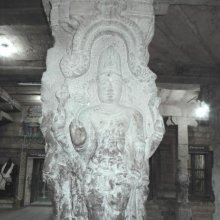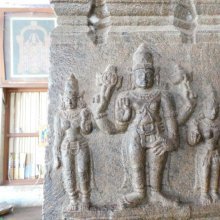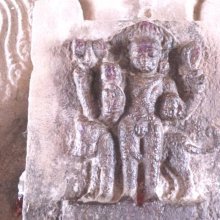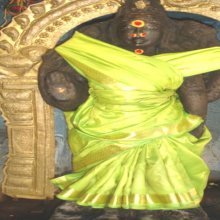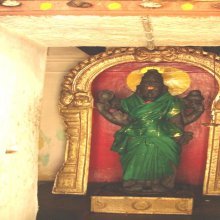Samabhanga, Sama-bhanga, Samabhaṅga: 2 definitions
Introduction:
Samabhanga means something in Hinduism, Sanskrit. If you want to know the exact meaning, history, etymology or English translation of this term then check out the descriptions on this page. Add your comment or reference to a book if you want to contribute to this summary article.
Images (photo gallery)
(+19 more images available)
In Hinduism
Shilpashastra (iconography)
Source: Google Books: The Book of Hindu Imagery: Gods, Manifestations and Their MeaningSamabhanga-asana; Literally: without bending. The normal starting position for standing representations. The god stands with his weight spread equally over his two feet, his body erect in tranquil equilibrium. A variation of this asana is sthanu, the pillar position”, (see illustration). This is the petrified position, e.g., of Shiva as an ascetic, when he stands deep in meditation for such a long time that one universe ends and another is created. Thus, another name for this aspect of Shiva is, Sthanu, “he who stands like a pillar.”
Source: Shodhganga: The significance of the mūla-beras (śilpa)Samabhaṅga (समभङ्ग) refers to one of the three types of bhaṅga (“inflexions of the body”) which is one of the three divisions of pratimālakṣaṇa (body postures of the icons), as defined according to texts dealing with śilpa (arts and crafs), known as śilpaśāstras.—The bend in the body of an icon is called bhaṅga (flexions or attitudes). Samabhaṅga is the equipoise body where the right and the left of the figure are disposed symmetrically, the sutra or plumbline passing through the navel from the crown of the head to a point midway between the heels. The bhaṅgas play a vital role in the postures of the deities and also while depicting them in dance. Gods and goddesses are mostly found in samabhaṅga pose, which is equivalent to the nata and unnata of dancing...

Shilpashastra (शिल्पशास्त्र, śilpaśāstra) represents the ancient Indian science (shastra) of creative arts (shilpa) such as sculpture, iconography and painting. Closely related to Vastushastra (architecture), they often share the same literature.
See also (Relevant definitions)
Partial matches: Bhanga, Cama, Sama.
Full-text (+23): Atibhanga, Abhanga, Shivottama, Kapalisha, Bhanga, Shyamalai, Parvati, Mojaghanjabala, Anandadi, Nilalohita, Antal, Bhavodbhava, Devadeva, Mayuranatha, Vijaya, Shankara, Karuppana, Garuda, Dandayutapani, Sthitakuncita.
Relevant text
Search found 11 books and stories containing Samabhanga, Sama-bhanga, Samabhaṅga, Sama-bhaṅga; (plurals include: Samabhangas, bhangas, Samabhaṅgas, bhaṅgas). You can also click to the full overview containing English textual excerpts. Below are direct links for the most relevant articles:
The Indian Buddhist Iconography (by Benoytosh Bhattachacharyya)
108 forms of Avalokiteśvara (7): Ānandādi Lokeśvara
108 forms of Avalokiteśvara (10): Kamaṇḍalu Lokeśvara
Manasara (English translation) (by Prasanna Kumar Acharya)
Gati in Theory and Practice (by Dr. Sujatha Mohan)
Gati in classical dance form of Oḍissi < [Chapter 4 - Practice of Gati]
Gati in classical form of Bharatanāṭya < [Chapter 4 - Practice of Gati]
Temples in and around Madurantakam (by B. Mekala)
Sri Venkateswarar Temple < [Chapter 4 - Prominent Temples in Madurantakam Taluk]
Kodandarama or Kothandarama Perumal Temple—Madurantakam < [Chapter 4 - Prominent Temples in Madurantakam Taluk]
Atcheeswarar Temple at Acharapakkam < [Chapter 4 - Prominent Temples in Madurantakam Taluk]
Manikanteesvara Temple: Kani Pakkam < [January – March, 1989]
Indian Sculpture: Orissa's Role < [April 1957]
Indian Sculpture: Orissa's Role < [April 1957]
Pallava period (Social and Cultural History) (by S. Krishnamurthy)
Architecture of the Mamalla Style < [Chapter 2 - Origin of Sculptural Art—Its Development and Scheme]
Other Gods and Goddesses < [Chapter 3 - Socio-Religious Life]
Scheme of Pallava Sculptures < [Chapter 2 - Origin of Sculptural Art—Its Development and Scheme]
Related products
